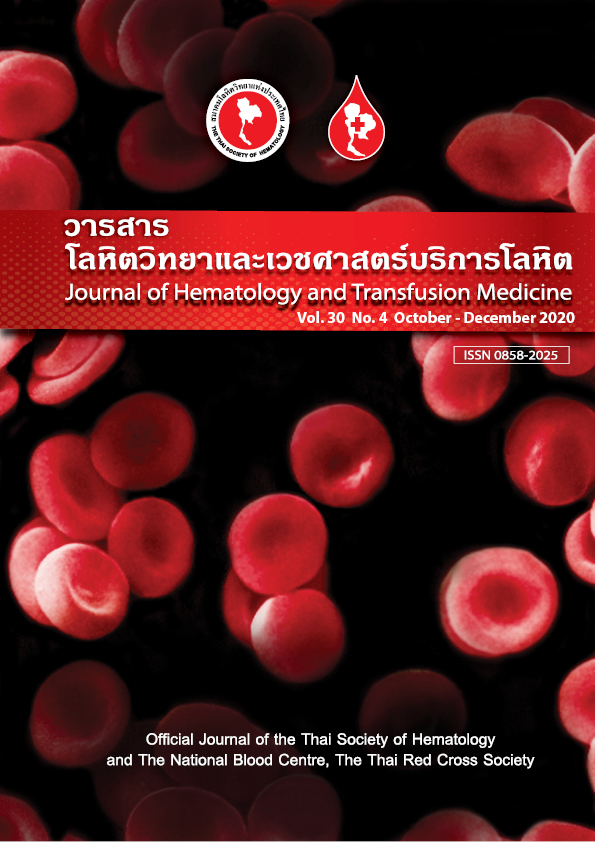Analysis of pretransfusion testing events occurring in patients at Thammasat University Hospital
Keywords:
Pretransfusion testing, Patients, AlloantibodiesAbstract
Abstract:
Introduction: ABO grouping and Rh(D) typing, antibody screening, and crossmatching are essential components of pretransfusion testing before blood transfusion in patients. Various problems that occurred in pretransfusion testing caused delayed resolutions before blood can be released for patients. This study aimed to analyze the pretransfusion testing problems in patients who requested transfusions at Thammasat University Hospital. Meterials and Methods: This retrospective study was conducted at the Blood Bank, Thammasat University Hospital from January 2019 to December 2019. Data regarding sex, age, transfusion, pregnancy history and pretransfusion testing results were collected and analyzed. Results: Totally, 23,659 patients’ transfusion requests were evaluated. One case of ABO discrepancy was due to the extra cold alloantibodies of the Lewis system. The prevalence of unexpected red cell antibodies was 2.46% (581/23,659) and group B patients were significantly higher than other blood groups. More than 90% of cases could be identified antibody specificity in our laboratory and the most common alloantibodies were anti-Mia, anti-E, and anti-c. The other undetermined specificities were due to autoantibody combined with a mixture of alloantibodies and unidentified antibodies, which could provide either compatible or least incompatible phenotype-matched blood without any signals of transfusion reactions. Conclusion: These findings in patients represented potentially clinically relevant data on red cell antibodies. The association with frequently observed alloantibodies is predictive of the appropriate management of antigen-negative blood to ensure prompt and safe blood transfusions.
บทคัดย่อ
บทนำ การตรวจหมู่เลือด ABO การตรวจ Rh(D) การตรวจกรองแอนติบอดีและการตรวจความเข้ากันได้ของเลือดเป็นส่วนประกอบสำคัญของการตรวจก่อนการให้เลือดกับผู้ป่วย ปัญหาต่างๆ ที่เกิดขึ้นในการตรวจก่อนการให้เลือดทำให้เกิดความล่าช้าทั้งการแก้ปัญหาและการจ่ายเลือดให้กับผู้ป่วย วัตถุประสงค์ การศึกษานี้เพื่อวิเคราะห์ปัญหาต่างๆ ที่เกิดขึ้นในการตรวจก่อนการให้เลือดในผู้ป่วยที่ขอเลือด ณ โรงพยาบาลธรรมศาสตร์เฉลิมพระเกียรติ วัสดุและวิธีการ เป็นการศึกษาย้อนหลังที่ธนาคารเลือด โรงพยาบาลธรรมศาสตร์เฉลิมพระเกียรติ ตั้งแต่เดือนมกราคม พ.ศ. 2562 ถึงเดือนธันวาคม พ.ศ. 2562 โดยรวบรวมและวิเคราะห์ข้อมูลของเพศ อายุ ประวัติการได้รับเลือดและการตั้งครรภ์ รวมทั้งผลการตรวจก่อนการให้เลือด ผลการศึกษา ได้ประเมินข้อมูลผู้ป่วยที่ขอเลือดจำนวนทั้งหมด 23,659 ราย พบว่า ผู้ป่วย 1 ราย มีปัญหา ABO discrepancy เนื่องจากมีแอนติบอดีของหมู่เลือดระบบ Lewis ความชุกของการตรวจพบแอนติบอดีเท่ากับ 2.46% (581/23,659) และผู้ป่วยหมู่ B ตรวจพบแอนติบอดีสูงกว่าผู้ป่วยหมู่อื่นอย่างมีนัยสำคัญ ห้องปฏิบัติการสามารถตรวจแยกชนิดของแอนติบอดีได้มากกว่า 90% แอนติบอดีที่พบได้บ่อยคือ anti-Mia, anti-E, และ anti-c ส่วนแอนติบอดีที่ไม่สามารถแยกชนิดได้ ได้ส่งไปตรวจที่ศูนย์บริการโลหิตแห่งชาติ สภากาชาดไทย พบว่า เป็น autoantibody ร่วมกับ alloantibodies อื่นและ unidentified antibodies ซึ่งสามารถให้เลือดที่เป็น phenotype-matched ทั้งที่เป็น compatible และ least incompatible โดยที่ไม่พบอาการแสดงของปฏิกิริยาอันไม่พึงประสงค์จากการได้รับเลือด สรุป จากผลการศึกษาในผู้ป่วยพบว่า ปัญหาส่วนใหญ่เกิดจากแอนติบอดีต่อหมู่เลือดที่มีความสำคัญทางคลินิก ดังนั้นความสัมพันธ์ของการตรวจพบ alloantibodies ชนิดที่พบได้บ่อยเป็นตัวบ่งชี้ในการบริหารจัดการคัดเลือกเลือดที่เป็น antigen-negative ให้เหมาะสมเพื่อยืนยันการให้เลือดที่ปลอดภัยและทันเวลากับผู้ป่วย



